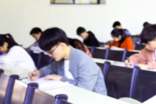- 相关推荐
2015年职称英语考试《理工类C级》教材新增
阅读理解

第九篇 An Essential Scientific Process
All life on the earth depends upon green plants. Using sunlight, the plants produce their own food. Then animals feed upon the plants. They take in the nutrients the plants have made and stored. But that’s not all. Sunlight also helps a plant produce oxygen. Some of the oxygen is used by the plant, but a plant usually produces more oxygen than it uses. The excess oxygen is necessary for animals and other organisms to live.
The process of changing light into food and oxygen is called photosynthesis. Besides light energy from the sun, plants also use water and carbon dioxide. The water gets to the plant through its roots. The carbon dioxide enters the leaves through tiny openings called stomata. The carbon dioxide travels to chloroplasts, special cells in the bodies of green plants. This is where photosynthesis takes place. Chloroplasts contain the chlorophylls that give plants their green color. The chlorophylls are the molecules that trap light energy. The trapped light energy changes water and carbon dioxide to produce oxygen and a simple sugar called glucose.
Carbon dioxide and oxygen move into and out of the stomata. Water vapor also moves out of the stomata. More than 90 percent of water a plant takes in through its roots escapes through the stomata. During the daytime, the stomata of most plants are open. This allows carbon dioxide to enter the leaves for photosynthesis. As night falls, carbon dioxide is not needed. The stomata of most plants close. Water loss stops.
If photosynthesis ceased, there would be little food or other organic matter on the earth. Most organisms would disappear. The earth’s atmosphere would no longer contain oxygen. Photosynthesis is essential for life on our planet.
词汇:
nutrient n.营养物
organism n.生物体,有机体
carbon dioxide n.二氧化碳
chloroplast n.叶绿体
molecule n.分子
vapor n.水蒸气
oxygen n.氧气
photosynthesis n.光合作用
chlorophyll n.叶绿素
glucose n.葡萄糖
cease v.停止
注释:
1.Then animals feed upon the plants.动物以植物为食。
练习:
1.In the first paragraph,the word “excess” means
A heavy.
B extra.
C green.
D liquid.
2.Which of the following does not move through a plant’s stomata?
A Carbon dioxide.
B Water vapor.
C Oxygen.
D Food.
3.In the title, the term Essential Scientific Process refers to
A photosynthesis.
B the formation of glucose.
C global warming.
D water getting to the roots of plants.
4.This passage is primarily developed by
A explaining a process.
B telling a story.
C comparing and contrasting.
D convincing the reader of plants’ importance.
5.Another good title for this passage would be
A Oxygen and Carbon Dioxide.
B Plants and Their Roots.
C How Photosynthesis Works.
D Why Our Earth Needs Water.
答案与题解:
1.B 前文讲到,植物产生的氧气一部分被植物自身消耗了,但植物消耗的氧气量远小于它们产生的氧气,因此可以推测这句话的意思应该是剩余的氧气对于动物以及其他生物体的生存是至关重要的。excess在句中的意思是“超额的”,与extra“额外的”意思相近。
2.D 从第三段的第一、二句得知,二氧化碳、氧气和水蒸气都能从气孔中通过,唯一一个没有提到的是food“养分、食物”,因此该题选D项。
3.A 文章通篇都在讲Photosynthesis,即光合作頌钠作用和重要性,文章结尾又重申了Photosynthesis is essential for life on our planet,因此选A项。B项是光合作用的一个部分,C、D项则毫不相干。
4.A 文章先是介绍了进行光合作用所需的原料和组织,又介绍了光合作用的过程,因此整个逻辑应该是解释过程,而不是讲故事或比较对比。D项是“向读者说明植物的重要性”,这确实是文章的一个目的,但不是文章的组织方式。
5.C 文章的主题是光合作用的基本原理,因此选项C。A、B项在文中有提及,但不是主旨,D项与本文无关。
补全短文
第五篇 A Record-Breaking Rover
NASA’s Mars rover Opportunity has boldly gone where no rover has gone before—at least in terms of distance. ____1____
On July 27, after years of moving about on Martian ground, the golf-cart-sized Opportunity had driven more than 24 miles, beating the previous record holder—a Soviet rover sent to the moon in 1973.
“This is so remarkable considering Opportunity was intended to drive about 1 kilometer and was never designed for distance,” says John Callas, the Mars Exploration Rover Project Manager.
____2____ “But what is really importantly is not how many miles the rover has racked up, but how much exploration and discovery we have accomplished over that distance.”
OPPORTUNITY
The solar-powered Opportunity and its twin rover, Spirit, landed on Mars 10 years ago on a mission expected to last 3 months. ____3____
Spirit stopped communicating with Earth in March 2010, a few months after it got stuck in a sand pit. But Opportunity has continued to collect and analyze Martian soil and rocks.
During its mission, Opportunity has captured, and sent back to Earth, some 187,000 panoramic and microscopic images of Mars with its cameras. ____4____
MARATHON ROVER
The rover doesn’t seem to be ready to stop just yet. If Opportunity can continue on, it will reach another major investigation site when its odometer hits 26.2 miles. ____5____
Researchers believe that clay minerals exposed near Marathon Valley could hold clues to Mars’s ancient environment1. Opportunity’s continuing travels will also help researchers as they plan for an eventual human mission to the Red Planet.
词汇:
Mars rover n. 火星车
panoramic adj. 全景的
odometer n. 里程计
rack up v. 积累
microscopic adj. 微观的
注释:
1.could hold clues to Mars’s ancient environment:含有与火星早期环境有关的线索。
练习:
A It has also provided scientists with data on the planet’s atmosphere, soil, rocks, and terrain.
B He works at NASA’s Jet Propulsion Laboratory in Pasadena, California.
C Scientists call this site Marathon Valley, because when the rover reaches the area, it will have traveled the same distance as the length of a marathon since its arrival on Mars.
D Opportunity has been working on Mars since January 2004.
E The objective of the rovers was to help scientists learn more about the planet and to search for signs of life,such as the possible presence of water.
F Since arriving on the Red Planet in 2004, Opportunity has traveled 25.01 miles, more than any other wheeled vehicle has on another world.
答案与题解:
1.F 前文讲“机遇号”在距离上比之前的任何漫游车行进的距离都长,因此接下来应该讨论关于行进距离的问题。
2.B 前文引入了一个新人物John Callas,而后文是他说的一些话,因此这里应该填写的内容是对这个人的进一步介绍。
3.E 前文讲了同时被送入太空的两台漫游车“机遇号”和“勇气号”,因此下文应该对它们的情况进行介绍,而关于发射目的的介绍在这里是合适的。
4.A 前文讲到“机遇号”给地面传回了许多照片,而选项A中讲到它还给地面传回了许多其他信息,在这里是一致的。
5.C 前文讲漫游车在行进到26.2英里的时候会到达一个地点,而后文提到了马拉松谷这个地方,因此这里应该是关于这个地点的介绍。
【职称英语考试《理工类C级》教材新增】相关文章:
职称英语考试理工类C级词汇强化试题10-26
职称英语考试理工类C级词汇选项真题12-05
职称英语考试理工类C级完形填空真题12-05